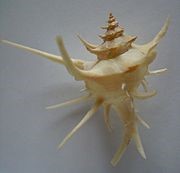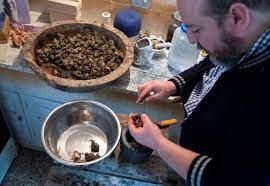The Color Purple
Cathy Koos
From the garb of royalty to the name of a movie to Prince’s theme song, the color purple has led a charmed life. A symbol of imperial authority and status, purple’s elusive dye contributed to its allure.
Prior to the Bronze Age, dyes were sourced from natural sources such as plants, lichens, and mushrooms, giving muted understated colors. Any purples from those sources were often ephemeral in sunlight. Whortleberries or lichen, overdyed with madder or woad, produced a somewhat acceptable purple dye.

Figure 1Peter Paul Rubens, Hercules and the Discovery of the Secret of Purple, 1636. Wiki Commons
Then came a fortuitous day in the 14th century BCE. Imagine, if you will, being the lucky woman and her dog strolling along the beach in Tyre, an ancient Phoenician city, when you come upon a tiny sea snail (Poirieria zelandica Spiny Murex) with purple oozing from its backside. When her dog bit into the snail, his mouth was stained purple, and thus began the manufacture of Tyrian purple.

Figure 3Poirieria zelandica Spiny Murex, Wikipedia
Pliny The Elder, in his seminal “Natural History,” details the complicated process: “Leave them to steep for a period of three days, and no more, for the fresher they are, the greater virtue there is in the liquor. It is then set to boil in vessels of tin, and every hundred amphorae ought to be boiled down to five hundred pounds of dye, by the application of moderate heat…About the tenth day, generally, the whole contents of the cauldron are in a liquified state, upon which a fleece, from which the grease has been cleansed, is plunged into it by way of making trial; but until such time as the color is found to satisfy the wishes of those preparing it, the liquor is still kept on the boil. The tint that inclines to red is looked upon as inferior to that which is of a blackish hue. The wool is left to lie in soak for five hours. Then after carding it, it is thrown in again, until it has fully imbibed the color.”
To set the color, human urine and wood ash were used as the mordant. The price to pay for this marvelous color is for the wearer to be clad in purple was a distinct odor of decayed fish and urine. Due to the stench, purple dye manufacturers were banished outside the city walls, along with the leather tanners, wool fullers, and other malodorous enterprises.
Approximately 12,000 snails yielded only 1.4 grams of pure purple – enough for one garment. Worth its weight in gold as one pound of pre-dyed wool would set you back one pound of gold.

Figure 4Reuters, Amira Karauod, artisan
The Phoenicians quickly saw purple dye as a key trade commodity. Taking up little cargo space, this high value trade item soon spread from the Mediterranean ports to the far reaches of the Roman Empire and Briton.
Once synthetic dyes were developed, there was an alternative to the labor-intensive snail process. In 1856 while attempting to formulate quinine from coal tar, a London university student named William Henry Perkins, instead discovered how to synthesize purple dye, which he named mauvine. Thus, beginning the booming synthetic dye industry.
Today, Tyrian purple is produced by just a handful of artisans. While one may assume the intense harvesting of these predatory snails may have affected its population, according to NPR climate change may have a more lasting impact. https://www.npr.org/2007/08/08/12600707/purple-snail-may-be-climate-change-casualty